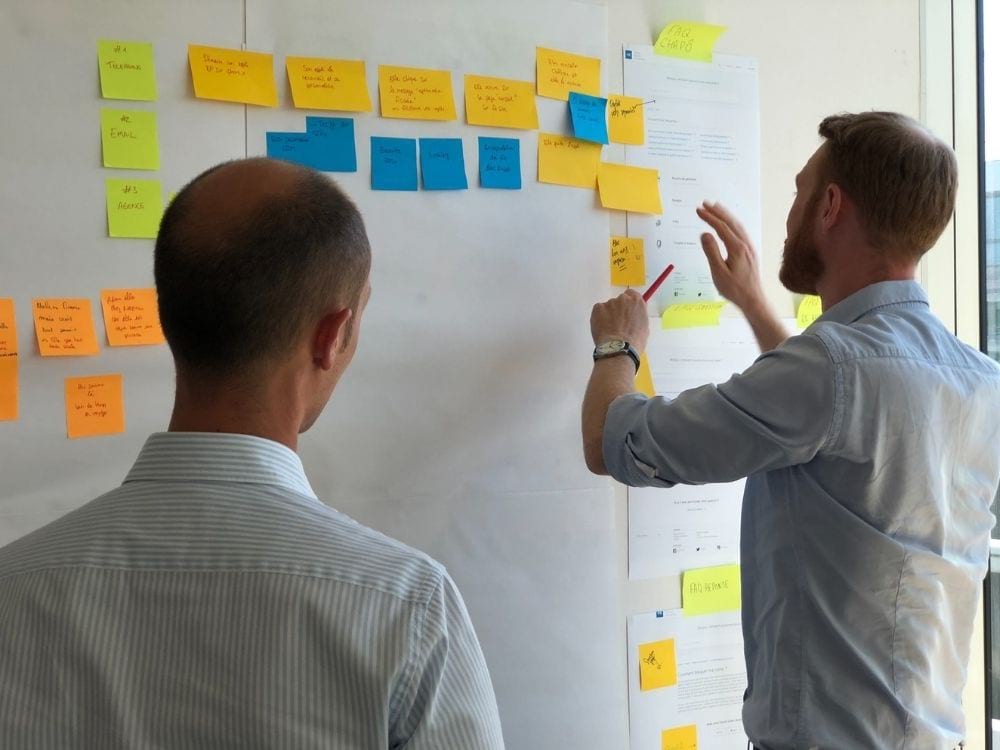Do you know the specific touchpoints your customer has in order to make a purchase decision? Can you confidently say that your website is optimized for sales, your social media is building trust, and your PPC ads are high converting?
Or, like many B2B businesses, are your marketing efforts a lot of moving parts that never quite seem to fit together?
If you can relate, you probably haven’t spent the time buyer journey mapping. And you’re alone, only around 39% of companies have a dedicated customer journey map.
This is a simple yet highly effective strategy for streamlining your marketing, understanding your customers better, and boosting your ROI.
In this post, we’ll show you how to create your own customer journey map and give you examples to help you get started.
Want to know how to grow your business faster with cold email outreach? Check out our cold outreach guide to find out how.
What’s included in a customer journey map?
Customer journey mapping is the visual representation of the stages a lead goes through to become a paying customer.
Each touchpoint your leads have with your business forms the customer journey that takes them from being unaware of your brand, to making a purchasing decision.
Buyer journey mapping allows you to see your marketing efforts from the customers’ perspective and figure out where you’re experiencing client drop off.
There are different kinds of customer journey map and each will look different depending on your business, but there are four main components that are always included:
- Customer actions
- Emotions
- Pain points
- Solutions
Each significant milestone a potential customer reaches in the buying journey will be a new stage on your map, with routes and strategies to get them to the next step.
What is a touchpoint in a customer journey map?

A touchpoint is any instance where a customer has the opportunity to form an opinion about your business in the decision stage.
Whenever your brand or sales team or marketing efforts come into contact with a customer, that’s a touchpoint.
Touchpoints aren’t always positive, and they come in a range of forms including:
- PPC ads
- Website pages
- Google reviews
- In-person recommendations
- Outreach campaigns
- Social media posts
- Email marketing
When mapping out your buyer journey, you need to consider all the touchpoints your customer could hit and figure out how you can improve on each one.
From the initial contact with your brand to customer reviews and social media contact and your website, each touchpoint should be a positive user experience for your customer and build trust as they move through the journey.
Types of Customer Journey Maps and Examples
There are four different types of effective customer journey map and the right one for you will depend on what you’re trying to achieve by creating a customer journey.
- Current State
This is the most popular type of client journey map. It gives a visual representation of the actions, thoughts, and emotions of your customers while they interact with your brand.
This type allows you to understand customer behavior and see how your customer feels and reacts in their current state, wherever they may be on the client journey. This then allows you to tailor your marketing to speak to them more directly.
- Day in the Life
This type of customer journey map has a wider lens and focuses on the client as a whole, rather than narrowing in on their interactions with your brand specifically.
You’ll map out the thoughts, feelings, and actions of potential buyers on a day to day basis, whether or not that includes your brand.
This type of customer map allows you to get a better understanding of who your target audience is, what is important to them, and how to tailor your marketing to feel more personalized.
- Future State
This type of map focuses on the future interactions of your target customer with your business. You’ll map out the likely interactions that clients will have with your brand based on their projected thoughts, feelings, and actions.
This type of map is useful when you’re planning your future goals and vision for your business and need to figure out what customers will need from you in the future.
- Service Blueprint
The service blueprint is almost an add-on to the above journey maps. You’ll start with one of the first three options, and then layer on the services, technologies, and processes you need to facilitate movement through the planned out journey.
This type of map helps to identify gaps in the journey or potential problems that are stalling progression you need to work on.
Customer Journey Mapping Best Practices

When you’re planning your customer journey map for the first time, here are a few key tips to keep in mind.
- Know your goal
Do you want to improve the overall buyer experience? Launch a new product? Get to know your target demographic in the awareness stage?
All of these are good options, but start with one main goal in mind to help get more specific when creating your journey map. If you have too many goals, the map will become too cluttered and complicated to be of any real value.
- Survey existing customers
No one knows your customer experience better than previous customers. Set up a short survey and ask previous customers to fill it out. An incentive such as a discount code for their next purchase will help secure respondents, but make it clear you want honest answers, even if they’re negative!
- Ask your customer service reps
If you have dedicated staff working in a customer service role, ask them what questions come up most frequently. You might find the same customer pain points, confusion, or questions coming up over and over again.
If this is the case, you know it’s something that needs to be addressed when mapping the B2B buyer journey.
- Create multiple maps for different buyers
If you’re targeting different demographics or you have different services that appeal to different buying personas, make different maps for each. In fact, over half of companies that use maps have at least three to five different versions.
Not all customers operate the same way, so your journey map needs to be tailored to the specific buyer persona who is looking for a particular product or service.
- Review and update your journey map
Whenever you have a new launch or your business goes through a change, you should revisit your customer journey map and update it.
Even something small like adding a new page to your website or changing your contact form could become a new obstacle for your customers. So take the time to review the customer journey map and know how they will be affected by change.
How to Create a Customer Journey Map

Now you know the importance of a customer journey map and best practices, let’s look at how you create one for your business to help turn cold leads into buying customers.
Set your objective
As we talked about before, begin with a clear objective in mind. What is the goal of the map? What are you trying to achieve by making one?
Make your objective clear and singular so it’s clear to see if your map is straying off course during creation.
Conduct customer research
Next, put together your questionnaire to send out to loyal customers for feedback. You can also reach out to ideal customers to gain insight into their pain points and what is stopping them from making a purchasing decision.
What you ask will be tailored to your business and offer, but some general questions you can add include:
- How did you hear about our brand?
- What did you like/dislike about our website?
- How easy do you find our website to navigate?
- What problem were you trying to solve with our product/service?
- If you didn’t make a purchase, what was the obstacle(s) in your way?
- How helpful would you rate our customer service on a scale of 1 to 10 and why?
- What can we do to improve our business to make buying from us a more enjoyable experience?
- Have you ever seen us on social media? Do you enjoy our content?
- What would like to see us share on social media that you would find useful?
Your questionnaire can target any of the customer journey touchpoints you have with your customers to find out how they feel about each step and what they would like to see improved.
List out all your touchpoints
The touchpoints are all the places your customers interact with your brand from your website to your social media channels.
List out all the areas they interact with you so you know what to include on the buyer journey map. This will include:
- Your website
- Contact forms
- Landing pages
- Social media platforms
- PPC ads
- Third-party review sites
- Print marketing
List out the actions customers take
Now you have your touchpoints, list out the specific actions customers take at each one. This will show you if your customers are expected to take too many steps at a given touchpoint.
For example, on your website, they may have to click to a service page tab, scroll down, enter information into a contact form, hit submit, etc.
The more you can simplify the actions at each step, the smoother the buying process will be.
List the obstacles & pain points
At each stage of the journey, list out any obstacles or pain points that are preventing the customer from moving forward.
For example, at the very beginning of the journey, a common obstacle is lack of recognition and trust in your brand.
When it comes closer to the point of sale, a more common obstacle might be the cost or delivery time.
Highlighting the pain points in the journey will help you mitigate them as much as possible and will give you a clear direction in your marketing strategy.
Figure out what resources you need
As soon as you have the touchpoints and obstacles mapped out, it will become clear where you need new systems and technology to improve your current system.
Take inventory of the resources you already have, and research what you’ll need to improve the buyer journey.
For example, you may find that your sales team isn’t following up quickly enough with customers who reach out on your website.
A fix for this would be Bant’s customer acquisition dashboard which allows sales reps to track conversations with leads, automate cold outreach, and more, all in one easy to use software.
Take the customer journey yourself
Once you have your map with new and improved processes, go on the customer journey to see if it works in practice.
You might find parts of your website are still complicated to navigate or there are gaps in your FAQ that need to be filled.
Giving your journey map a test run is an easy way to spot any glaring holes still in the customer journey before you begin your real-time analysis.
Analyze results
Once you have your customer journey as optimized as possible, keep track of your Google analytics to analyze your progress.
This can be done by tracking:
- Website visits
- Bounce rate
- Button clicks
- PPC clicks
- Social media engagement
- Contact form submissions
Ultimately, you should see an improvement in engagement and customer retention when you have nailed your buyer journey.
But if you’re still seeing high drop off or low engagement, analyze the journey again and figure out where you’re going wrong.
Even if you do see good results, regular analysis and tweaking to improve will help you optimize the customer journey map and make the buying experience as positive as possible.
Conclusion
Creating a customer journey map is a crucial step in any B2B business. It’s important to get inside the mind of the customer and know what their pain points are in order to help them overcome obstacles and make that buying decision.
Once you have an optimized customer journey, you can be much more confident in your marketing and outreach efforts.
That’s where Bant comes in. With an all-in-one lead generation and customer acquisition dashboard, you can get a steady stream of new leads that move through your customer journey that much faster.
Automate your customer acquisition by scheduling a demo today with one of our representatives.

